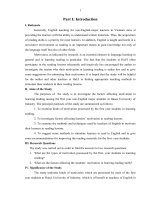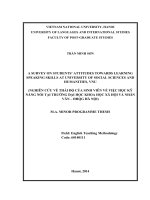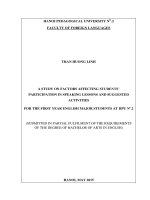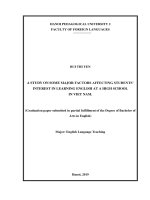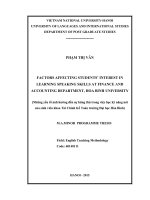FACTORS AFFECTING STUDENTS’ INTEREST IN LEARNING SPEAKING SKILLS AT FINANCE AND ACCOUNTING DEPARTMENT HOA BINH UNIVERSITY
Bạn đang xem bản rút gọn của tài liệu. Xem và tải ngay bản đầy đủ của tài liệu tại đây (255.88 KB, 55 trang )
VIETNAM NATIONAL UNIVERSITY-HANOI
UNIVERSITY OF LANGUAGES AND INTERNATIONAL STUDIES
DEPARTMENT OF POST GRADUATE STUDIES
PHẠM THỊ VÂN
FACTORS AFFECTING STUDENTS’ INTEREST IN
LEARNING SPEAKING SKILLS AT FINANCE AND
ACCOUNTING DEPARTMENT, HOA BINH UNIVERSITY
(Những yếu tố ảnh hưởng đến sự hứng thú trong việc học kỹ năng nói
của sinh viên khoa Tài Chính Kế Toán trường Đại học Hòa Bình)
M.A.MINOR PROGRAMME THESIS
Field: English Teaching Methodology
Code: 60140111
HANOI - 2015
VIETNAM NATIONAL UNIVERSITY-HANOI
UNIVERSITY OF LANGUAGES AND INTERNATIONAL STUDIES
DEPARTMENT OF POST GRADUATE STUDIES
PHẠM THỊ VÂN
FACTORS AFFECTING STUDENTS’ INTEREST IN
LEARNING SPEAKING SKILLS AT FINANCE AND
ACCOUNTING DEPARTMENT, HOA BINH UNIVERSITY
(Những yếu tố ảnh hưởng đến sự hứng thú trong việc học kỹ năng nói
của sinh viên khoa Tài Chính Kế Toán trường Đại học Hòa Bình)
M.A. MINOR PROGRAMME THESIS
Field: English Teaching Methodology
Code: 60140111
Supervisor: Dr. Phạm Đăng Bình
HANOI - 2015
DECLARATION
I, Pham Thi Van, hereby state that, this minor thesis entitled: “Factors
affecting students' interest in learning speaking skills at Finance and
Accounting Department, Hoa Binh University” is the result of my own
research and all the material in this study which is not my own work has been
identified and acknowledged. I also state that the substance of the thesis has
not, wholly or in part, been submitted for any degree to any other universities
institutions.
Hanoi, April, 2015
Phạm Thị Vân
i
ACKNOWLEDGMENTS
During the process of writing this thesis, I have been fortunate to
receive supports and assistance from many people.
First and foremost, I am deeply grateful to my supervisor, Dr. Phạm
Đăng Bình, who has been ready and willing to help me make my study
possible. He has put enormous effort into editing and in providing valuable
comments. I would not have completed the thesis without his help and
sympathy.
I would also like to convey my deepest thanks to all my teachers of the
post graduate Department of University of languages and International studies
- Vietnam National University and Hoa Binh University whose fundamental
knowledge about language and language teaching and learning is of great
importance to the achievement of my academic study.
I am most thankful to the students of Finance and Accounting
Department, Hoa Binh University who help me to gather information for my
survey questionnaire.
I would also like to take this opportunity to show my deep thanks to all
the teachers at Finance and Accounting Department, Hoa Binh University for
their constructive suggestion for this research, and for their willingness to
give information for my survey questionnaire.
Last but not least, I owe my deep thanks to my family and friends who
have helped and encouraged me while I was conducting the research.
ii
ABSTRACT
It is considered that speaking is given the most important account of
four skills in learning English. In comparison with other skills, speaking will
be used most often in our life. However, in reality, students at Finance and
Accounting Department, Hoa Binh University are not much interested in
speaking English.
The study focuses on the factors affecting students' interest in learning
speaking skills at Finance and Accounting Department, Hoa Binh University.
Once the problems have been identified, suggestions to improve the situation
of teaching and learning English for teachers and students at Finance and
Accounting Department, Hoa Binh University would be made.
In this paper, the researcher uses “survey questionnaire” for 150
students at Finance and Accounting Department and seven teachers teaching
the students
iii
LIST OF ABBREVIATIONS
CLT: Communicative Language Teaching
HBU: Hoa Binh University
iv
LIST OF TABLES AND CHARTS
1. Tables
Table 1: Students’ reasons for learning speaking skill
Table 2: Students’ interest in speaking activities
Table 3: Students’ factors make them not interested in speaking English
Table 4a, 4b: Students’ opinions about your teacher’s method and
characteristics
Table 5: Students’ opinion about classroom’s size, facilities, and
materials for speaking
Table 6: Teachers’ attitude towards speaking skill
Table 7a: Teachers’ method
Table 7 b: Teachers’ activities
Table 8: Teachers’ opinion of students’ factors making them less
interested in speaking English?
Table 9: Teachers’ suggestions to enhance students’ interest in speaking
activities
2. Charts
Chart 1: Students’ years of learning English
Chart 2: Students’ opinions about the importance of English speaking
skill
Chart 3: Students’ assessment about their own abilities in speaking skill
Chart 4: Teachers’ assessment about students’ speaking ability
v
TABLE OF CONTENTS
Declaration i
Acknowledgements ii
Abstract iii
List of abbreviations iv
List of tables and charts v
Table of contents vi
Part A: Introduction 1
1.Rationale of the study 1
2. Aims of the study 1
3.Significance of the study 1
4.Scope of the study 2
5. Research method of the study 2
6.Organization of the study 2
Part B: Development 4
Chapter 1: Literature review 4
1.1.Interest 4
1.2.Theory of speaking 4
1.1.1.Concept of speaking 4
1.1.2.The role of speaking in teaching and learning 6
1.1.3.Teaching speaking skills in CLT approach 6
1.3. Factors affecting students’ interest in speaking 8
1.3.1. Students’ factors 8
1.3.1.1. Students’ language proficiency leve 8
1.3.1.2. Students’ personality factors 8
1.3.2.Teachers’ factors 9
1.3.2.1. Teachers’ teaching methods 9
1.3.2.2. Teachers’ knowledge and characteristics 10
1.3.3. Objective factors 10
1.3.3.1. Classroom size 10
1.3.3.2. Facilities in classroom 11
vi
1.3.3.3. Reading materials and their roles 11
Chapter 2: Methodology
2 .1. . Background of the study 13
2.1.1. Short description of Hoa Binh University ( HBU) 13
2.1.2. The teachers 13
2.1.3. The students at the Finance and Accounting Department 13
2.1.4. The materials and syllabus 14
2.2. Research questions 16
2.3. Participants 16
2.4. Data collection instruments 16
2.5. Conclusion 17
Chapter 3: Results and discussions 18
3.1. Data analysis 18
3.1.1. Results from survey questionnaires for students 18
3.1.1.1. Students’ years of learning English 18
3.1.1.2. Students’ opinions about the importance of English speaking skill. 19
3.1.1.3. Students’ reasons for learning speaking skill 19
3.1.1.4. Students’ assessment about their own abilities in speaking skill 20
3.1.1.5. Students’ interest in speaking activities 21
3.1.1.6. Students’ factors make them less interested in speaking English 21
3.1.1.7. Students’ opinions about your teacher’s method and characteristics.
22
3.1.1.8. Students’ opinion about classroom’s size, facilities, and materials for
speaking 23
3.1.2. Results from survey questionnaires for teachers 24
3.1.2.1. Teachers’ attitude towards speaking kill 24
3.1.2.2. Teachers’ assessment about students’ speaking ability 25
3.1.2.3. Teachers’ method and activities 25
vii
3.1.2.4. Teachers’ opinion of students’ factors making them less interested in
speaking English 27
3.1.2.5. Teachers’ suggestions to enhance students’ interest in speaking
activities 28
3.2. Findings and discussion 28
3.2.1. Students’ little interest in speaking English 29
3.2.2. Students’ factors 29
3.2.3. Teachers’ factors 29
3.2.4. Classroom factors 30
3.2.5. Material factors 30
3.2.6. Conclusion 31
Chapter 4: Implications and recommendations 32
4.1. The students 32
4.2. The teachers 32
4.3. The classroom 33
Part C: Conclusion 34
1. Summary of the study 34
2. Limitation and suggestions for further study 35
2.1. Limitation 35
2.2. Suggestions for further study 35
References 37
Appendices I
viii
PART A: INTRODUCTION
1. Rationale of the study:
As an English teacher at Hoa Binh University (HBU), I realize that most of
the students do not often enjoy speaking period and they do not actively
contribute the speaking lessons. They always keep quiet, feel bored, passively
take note, some listen to better students speaking but do nothing. Other
students can do the grammar exercises and know new words and structures
well but they still cannot apply them in learning speaking skill. Moreover,
there are quite a lot of researches on learning English speaking skill but there
are no researches about factors affecting students' interest in learning
speaking skills at Hoa Binh University. For the reasons, I would like to carry
out a research with the title : “Factors affecting students' interest in learning
speaking skills at Finance and Accounting Department, Hoa Binh University”
to find out the common reasons why students are not interested in speaking to
handle the problems if possible and to help me and my colleagues enhance
our teaching methods.
2. Aims of the study:
The study is conducted to (1) investigate how students at Finance and
Accounting Department, Hoa Binh University are interested in learning
speaking skill, (2) identify the factors affecting students' interest in learning
speaking skills.
3. Significance of the study:
It is hoped that the result of the study will somehow be used as reference to
help students to feel interested in learning speaking skill in the next semesters.
Furthermore, the result of this study is also strongly believed to help me and
my colleagues at Hoa Binh University to better our own teaching methods, as
well as those who are in charge of teaching English speaking skill to non-
1
English major students at other universities and colleges in Viet Nam with the
same situation as at HBU
4. Scope of the study
The study will cover the possible factors affecting students' interest in
learning speaking skills including students’ language proficiency level,
attitude and motivation and personality, teachers’ teaching methods,
classroom size, facilities in classroom and materials. The subjects of the study
are only students at Finance and Accounting Department, Hoa Binh
University and teachers teaching the students
5. Research method of the study
The study will be conducted by using quantitative and qualitative methods.
To collect information, I will use survey questionnaires for both teachers and
students. All comments, remarks, recommendations and conclusion provided
in the study will be based on the data analysis
6. Organization of the study
Part A, Introduction, presents the rationale, aims of the study, significance
of the study, scope of the study, research methods and organization of the
study.
Part B, Development, consists of three following chapters
1. Chapter 1: Literature Review presents the concepts relevant to the
study
2. Chapter 2: The Study includes the background of the study, research
questions, the participants, data collection instruments, and data
collection procedures
3. Chapter 3. The results and discussions presents data analysis of the
study, findings and discussions
2
4. Chapter 4: Implications and recommendations gives some
suggestions to increase students’ interest in speaking lessons.
Part C. Conclusion summarizes all the main issues of the study and the
limitations as well as the suggestions for the further study.
3
PART B: DEVELOPMENT
CHAPTER 1: LITERATURE REVIEW
Chapter 1 includes three parts. The first part states the concept of interest. The
second presents the theory of speaking consisting of concept of speaking, the
role of speaking in foreign language teaching and teaching speaking skills in
CLT approach. The third part mentions the factors affecting students’ interest
in speaking
1.1. Interest
Ellis ( 1994) states that interest is one of the main elements of motivation and
a positive response to stimulate based on existing cognitive structure in such a
way that learner’s curiosity is aroused and sustained. In other words, interest
shows learners’ desire to learn the target language. It can be seen that students
who are given opportunities for communication will be interested in the
lesson.
Ellis (1985) also points out that “interest is engendered if learners become
self-centered”. This means they are able to determine their learning
objectives, choose their own way of achieving these, and evaluate their own
progress
I share the same ideal with Ellis that to have interest in learning a language is
very important.
1.2. Theory of speaking
1.1.1 Concept of speaking
Although there are a variety of concepts of speaking by different linguists,
most of them share the same idea that speaking is very important to
communication and it is the productive skill.
Bygate ( 1987) states that speaking is a skill which is very important and
requires as much attention as other skills, in both first and second languages.
In order to carry out most of their basic interactions and transactions, he needs
4
to be able to speak and express their ideas to other people. He also said that
“interaction is the use of language for maintaining communication between
participants” and “interaction skills are skills of deciding what to say, when to
say it and how to say it clearly ( Bygate, 1987, p.115). Besides, he says that
speaking is the choice of the right sounds in the patterns of rhythm and
intonation and the choice of words and inflections in the right order to convey
the right meaning. Therefore, in learning speaking skill, learners should know
not only how to produce specific points of languages such as grammar,
pronunciation, or vocabulary, but also the situations language is produced.
As stated by Burn and Joyce (1997), speaking is an interactive process of
constructing meaning concerning three periods: producing, receiving and
processing information ( Brown, 1994; Burns & Joyce, 1997).
Chaney and Burk ( 1998) states that speaking is the process of building and
sharing meaning through the use of verbal and non-verb symbols, in many
different contexts.
In the study of Brown and Yule (1983), spoken language consists of short,
fragmentary utterances in a range of pronunciation. Besides, speaking is
shown to have two main types of conversation namely dialogue and
monologue. In monologue, you give uninterrupted oral presentation while in
dialogue you interact with one or more other speakers for transactional and
international purposes
According to Florez (1999), speaking is an interactive process of constructing
meaning that involves producing`, receiving and processing information. It is
often spontaneous, open-ended and evolving
To summarize, there are many different points of view of speaking. Each of
them has their own strong points. However, in this study the author follows
Bygate’s concept of speaking, which said that speaking not only involves
grammatical competence but also sociolinguistic competence.
1.1.2The role of speaking in teaching and learning
5
According to Ur (1996), speaking is the most important of all four skills:
speaking, writing, listening and reading. Besides, it is also considered as the
first step to confirm who knows or does not know a language. Hymes &
Rogers (1986) said that, “ the goal of language teaching is to develop
communicative competence”. This means the main purpose of learning a
language is to speak the language well. Pattison (1992) shared the same
opinion that when people mention knowing or learning a language, they
actually mean that they are able to speak the language. Especially, Bygate
(1987) mentions that “ speaking is a skill which deserves attention every bit
as much as literacy skills, in both first and second languages”.
As the researchers, I totally agree with Ur that speaking is the most important
of four skills. For that reason, speaking skill plays an important role in foreign
language teaching because effective speaking ability helps learners not only to
acquire the language better but also to communicate successfully. In the
language classroom, speaking skill should be paid great attention to and
frequently judged. Moreover, our learners should try their best to be able to
speak with confidence in order to carry out many of their most basic
transactions.
1.1.3.Teaching speaking skills in CLT approach
Many years ago, traditional approaches in teaching English speaking such as
Grammar-Translation Method, Direct Method, Audio-Lingual were mostly
used but in recent years, CLT (Communicative Language Teaching
Approach) interests many English teachers. The approach appearing between
the 1960s and 1970s marks the beginning of major innovation within
language teaching and it has been widely accepted nowadays because of its
superior principles. Mitchell (1994) said that CLT covers the four skills of the
language including listening, reading, speaking and writing, which can lack in
other methods.
6
Furthermore, According to Savignon (2000:126-128), CLT helps English
learners to develop their communicative competence. He also said that CLT is
focused on promoting the development of functional language ability through
learner participation in communicative events.
CLT focuses on learners, so the role of teachers and learners in CLT isn’t
similar to that in traditional teaching methods. While in traditional methods
teachers talk much more than students and control them, in CLT methods
teachers is as a supporter for students. Nunan (1992) believes that teachers
should give students opportunities to talk by using group work and pair work.
Besides, Larsen- Freeman (1986) thinks that teachers in communicative
classroom talk less and listen more.
They should only set up the tasks, give instruction and check the answers or
give a feedback while students do most the speaking. Thanks to that, students
will gain more confidence in speaking and sharing their ideas
Richards (1994) also affirm that CLT is associated with its learner-center and
experienced-based tasks view of second language teaching. In CLT context,
learners are seen as active participants in the construction of knowledge,
rather than passive recipients of information provided by the teacher of the
textbook. In contrast, language teachers are no longer viewed as the authority
of the knowledge, playing a dominant role. Rather, they share different roles
such as communication facilitator, counselor, and group process manager to
create more fascinating experiences for the learners.
To summarize, CLT is the most appropriate way to teach speaking skills.
Therefore, the researcher considers it as one of the bases of the study.
1.3. Factors affecting students’ interest in speaking
According to Larsen (1986), factors affecting teaching speaking skills may
stem from students, teachers and objective factors such as classroom size,
classroom’s facilities and materials
1.3.1. Students’ factors
1.3.1.1. Students’ language proficiency level
7
It is undeniable that student’s language proficiency is one important factor
affecting students’ participation in speaking. According to Rod (1985), it is
undeniable that student’s language proficiency is one important factor
affecting students’ participation in speaking. According to Rod (1985),
proficiency consists of the learners’ knowledge of target language; it can be
synonymous with “competence”. Proficiency can be viewed as linguistic
competence or communicative competence. Second language proficiency is
usually measured in relation to native speaker proficiency.
1.3.1.2. Students’ personality factors
It is obvious that personality has a great influence on students’ participation in
speaking lesson. Participation usually means students speaking in class:
answer and ask questions, make comments, and join in discussions, etc.
Students who do not participate in those ways mentioned above are often
considered to be passive and are generally penalized when participation is
graded. Brown (2000) argues that personality is one of the affective factors
that are equally important for explaining differential success among second
language learners. Personality may be divided into extroversion and
introversion.
To sum up, in a class, students with different personality characteristics may
result in different level of participation in lessons and different of level of
success as well.
1.3.2. Teachers’ factors
1.3.2.1. Teachers’ teaching methods
Teacher’s teaching methods are very important because it can demotivate or
motivate students to get involved in speaking activities.
Activities
According to Le (2000) Vietnamese students’ passiveness in learning is the
product of traditional teaching. Therefore, teachers should use a variety of
teaching and learning methods in a single period so as to provide a great
8
variability of activities in the teaching and learning process to increase
students’ involvement. Moreover, Harmer
( 1991:12) says that in the class, teachers use a variety of activities, students
will be more interested in lesson than the class in which teachers use the same
activities. An activity can not appropriate all students, so teachers should use
different activities and methods interchangeably.
Teachers’ roles:
Unlike the roles of teachers in Grammar- Translation Method, Audio-Lingual
Approach or other traditional methods, the roles of teachers in CLT have been
changed significantly.
In CLT method, teachers should limit their speaking time so that students
have chance to speak in the class. According to Chaudron (1988), teachers
tend to make up over 70 % of the total talk in the classroom. When they talk
too much, students will have less opportunity to further practice the language
and therefore, they cannot enhance their speaking skills.
In CLT method, students are the centre in speaking activities and teachers
play a role as a controller, an organizer, and an assessor. Byrner (1986) points
out the roles of teachers according to three stages of teaching speaking: the
presentation stage, the practice stage and the production stage. At the first
stage, teachers play a role as an informant to prepare materials and present the
language to the students. At the second stage, teachers act as a conductor to
give all students as much time as possible to practice the presented language.
At the final stage, teachers play a role as a manager and a guide. Teachers
should encourage students try their best to speaking in spite of making
mistakes. After that, teachers should correct student’s mistakes or make
comments on their speaking.
1.3.2.2. Teachers’ knowledge and characteristics
Teachers’ knowledge and characteristics are the important factors affecting
students’ participation and interest in lesson. According to Barry (1993),
9
teachers should be natural, warm, pleasant and approachable in order to create
close relationship with students, which encourage them to participate in
speaking activities.
Especially, when teachers correct students’ mistakes, they should make nice,
gentle and tactful correction. Ur (2000) mentions that students may lose their
confidence and feel disappointed if teachers correct their errors in an
insensitive way. In short, teachers should be sensitive and tactful in correction
in order not to make students be shy and embarrassed.
1.3.3. Objective factors
1.3.3.1. Classroom size
In Hayes’ definition (1997), any classes with over 40 students can be
considered a large class. Teaching large classes is difficult for both teachers
and students in many reasons. First, teaching large classes requires more work
for the teacher as there are more learners to assist. Then, it is not easy for
teachers to motivate all students, make all of them concentrated, to have them
involved, and to get them promptly responded.
Barry (1993) shares the same idea that in large class, students have different
learning styles, preferences and levels of English proficiency. Therefore,
teachers cannot pay equal attention to all students in a large class and it is also
very difficult for teachers to organized suitable activities for all students in the
class.
Mathews (2006) said that multilevel classes can cause a lot of difficulties to
teachers in organizing the activities in speaking classes. Dalle (2003) also had
the same idea about this issue.
In short, to create good language learning environment, students should be
studied in small size classes with the equivalent students’ English level.
1.3.3.2. Facilities in classroom
According to Unnderwood (1987), facilities in classroom include desks,
chairs, radios, lights, air-conditioners, projectors, and things in classroom to
10
support for studying. Facilities in classroom have great effect on students’
learning as well as their attitude towards the subject matter.
1.3.3.3. Reading materials and their roles
Materials play an important role in exposing learners to the language,
especially in teaching and learning speaking skill. Therefore, selecting
speaking materials is very important. Selecting materials involves making
choices and decisions. To make good choices, we need to have good criteria
on which to base the decisions. These criteria such as factors about the
learners, the role of materials, the topics, the language, the presentation have
been put forwards for the analysis of materials and each of them has validity.
A good ESP material must contain interesting texts and enjoyable activities
which make students think, give them opportunities to use their existing
knowledge, skills and content that they and their teachers can cope with; truly
reflect what you think and feel about learning process; provide clear and
coherent unit structure to guide the students through various activities to
maximize the chances of learning; create a balance outlook which both reflect
the complexity of the task, yet make it appear manageable; introduce teachers
to new techniques and provide models of correct and appropriate language
use.
11
CHAPTER 2: METHODOLOGY
This chapter provides the methods for carrying out the study including
background of the study, research questions, the participants, the instruments
for collecting data and the procedures of data collection.
2.1. Background of the study
2.1.1. Short description of Hoa Binh University ( HBU)
Hoa Binh University , located in My Dinh II, Tu Liem, Ha Noi, was
established in 2008. It is known as one of the good private universities with
more than 70 % of the teachers being masters, doctors, associate professors
and professors. It has the big decrease in number of students from 236
students in 2008 to more than 4000 students in 2014. The university has
twelve branches of learning in university education and six in college
education. Finance and Accounting Department is one of the best and biggest
departments of HBU with the number of students accounting 35% of the
students at the university.
2.1.2. The teachers
12
There are seven teachers teaching in Finance and Accounting Department. All
of them are temporary female teachers. They are all young with the age from
25 to 37 and have at least 3 years of English teaching experience. Five of
them have acquired an M.A degree and two of them are following an M.A
course at Hanoi University of Foreign Languages and International Studies
and Hanoi University.
2.1.3. The students at Finance and Accounting Department
The number of students at Finance and Accounting Department is more than
1400. They are from different places in Vietnam. Most of them have studied
English before but they are not good at English and they are not interested in
English, especially speaking. At the university, they only study grammar and
vocabulary to pass written exams but do not pay much attention in speaking.
2.1.4. The materials and syllabus
Market Leader Elementary is used for the second year-students at Finance
and Accounting Department. Each week, students have 6 English periods.
The twelve units in the book cover the whole academic year comprising of
two -18 week semesters, so in each semester, the students study 6 units. In
class, teachers and students not only deal with students’ books but also other
components of the set like Practice File ( listening and pronunciation practice)
and Text Bank ( reading materials). In each unit of the material, the language
contents include starting up, vocabulary, listening, language focus, reading,
skills, and case study. The topics of the units are business-related topics
ranging from basic topics like introduction, work and leisure, travel to more
business-focused topics like sales, markets, companies, the Web.
Market Leader has been developed in association with the Financial Times,
one of the leading sources of business information in the world and it is made
13
by David Falvey, Simon Kent and David Cotton who have many years’
teaching experience in business
Book objectives: Market leader elementary is an elementary level business
English course for businesspeople and students of Business English. This
book is designed to greatly improve the ability to communicate in English in a
wide range of business situation. It is good for students of business to develop
the communication skills. They need to succeed in business and enlarge their
knowledge of the business world. Besides, it helps students become more
fluent and confident in using the language of business; therefore, students
increase their career prospects
Starting up: students are offered activities in which they discuss the topic of
the unit and exchange ideas about it
Vocabulary: Students learn important new words and phrases that they can
use when they carry out the tasks in the unit. A good dictionary, such as the
Longman Basic English Dictionary, will also help students to increase their
vocabulary
Discussion: Students can build up their confidence in using English and
improve their fluency through discussion activities
Reading: Students read adapted articles on topics from the Financial Times
and other newspaper. They can develop their reading skills and learn essential
business vocabulary. They can also be able to discuss the ideas and issues in
the articles
Listening: Students listen to the interviews with businesspeople. They will
develop listening skills such as listening for information and note taking
Language review: this section focuses on common problem areas at
elementary level. Students will be more accurate in their use of language.
14
Each unit contains two Language review boxes which provide a review of key
grammar items.
Skills: Students develop essential business communication skills such as
making presentations, taking part in meetings, negotiating, telephoning and
using English in social situations. Each skills section contains a “useful
language box” which provides students with the language they need to carry
out the realistic business tasks in the book
Case study: the case Study is linked to the business topics of each unit. They
are based on realistic business problems or situations and allow students to
use the language and communication skills they have developed while
working through the unit.
Therefore, students have opportunities to practice speaking skills in realistic
business situations. Each Case Study ends with a writing task. Models of
writing text types are given in the Writing File at the end of the Course book.
A full writing syllabus is provided in the Market Leader Practice File
Revision unit: four revision units are based on material covered in the
preceding three course book units
2.2. Research questions
As it has been stated, this study was carried out to find out Factors affecting
students' interest in learning speaking skills at Finance and Accounting
Department, Hoa Binh University. Thus, the study was designed in an attempt
to seek answers to the following questions:
1. To what extent are students interested in learning speaking skills
2. What are the factors affecting students' interest in learning speaking skills
2.3. Participants
The participants of the study were 150 students at Finance and Accounting
Department and seven teachers teaching the students. The students are chosen
15
